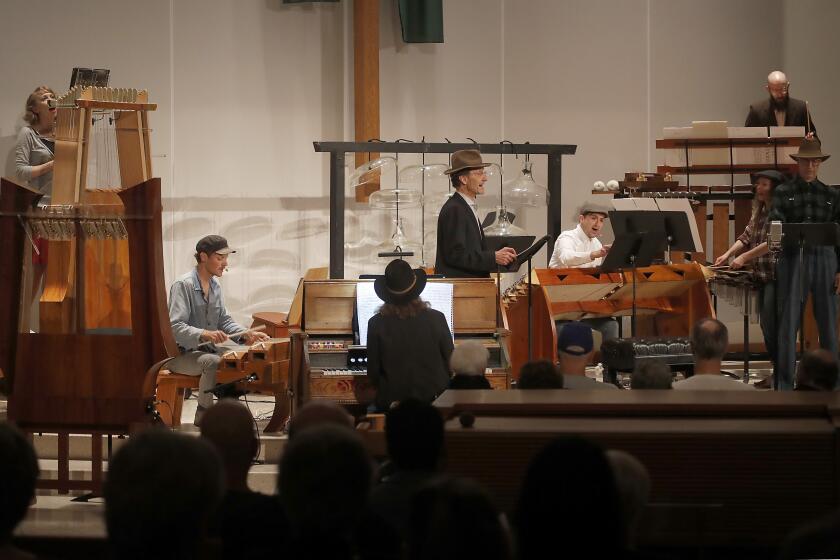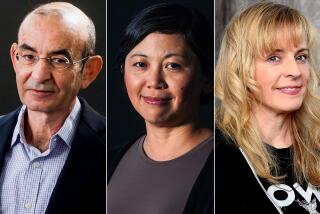Commentary: Wadada Leo Smith moves the UCLA Medal into the avant-garde

The recipients of the UCLA Medal, established in 1979 when the university turned 60 and its highest honor, have included U.S. presidents and other world leaders, Nobel-laureate scientists and writers, famed architects, Hollywood stars, sports figures, civic leaders and philanthropists. The list includes Jimmy Carter, Bill and Hillary Clinton (separately), Dorothy Buffum Chandler, Toni Morrison, Frank Gehry, Václav Havel, Kirk Douglas, Carl Sagan and John Wooden.
The musicians who have been given the medal are all household names: Ella Fitzgerald, Henry Mancini, Quincy Jones, Herb Alpert and, in 2017, Plácido Domingo. Friday night in a rehearsal room in the music building, the first medal for the school’s centennial went for the first time, surprisingly and importantly, to a progressive and far less well-known artist, the 77-year-old trumpet player and composer Wadada Leo Smith.
What is particularly exceptional is that the chancellor’s office committee that selects the recipient from faculty nominations is hardly likely to have a clue about Smith’s music. I say that because I have followed Smith’s music for a very long time and never passed up a chance to hear him. I also attended a talk, workshop and the ceremony that revolved around the UCLA Medal, as well the premiere of a new piece by Smith at Monk Space on Tuesday night. I also spoke briefly and informally with Smith.
Even so, I still don’t quite understand what he is up to or the system of composition he invented in 1965, called Ankhrasmation. But this much is inescapable. When Smith plays you cannot miss his rootedness to the ground on which he stands. He blows his trumpet onto the floor to produce vibrations that feel like they are part of the atmosphere. In his works for jazz ensembles, for string quartets or for the huge range of other forces he has set vibrating (he has written, he says, some 2,000 works), sound connects to substance in ways inexplicable but obvious.
A gracious, warm and approachable man, Smith can come across as a charmed mix of Buddha and Cheshire Cat. He readily explains himself, makes pronouncements and eagerly takes questions. He has something, be it prophetic or quotidian, to say about everything. He seems to make sense when he speaks and when he plays. But the sense is ephemeral. You’re left with mystery.
Smith grew up in Leland, Miss., immersed in Delta blues and then went on to absorb music from the West, Asia and Africa. He got his start in the 1960s in Chicago with the Assn. for the Advancement of Creative Musicians, which took avant-garde jazz into a new realm that requires a new name it has never really gotten. From 1994 to 2013, he taught at CalArts, where he influenced a generation or two of L.A. musicians and more of the new music produced in this town than he is normally given credit for.
The most experimental music of Ornette Coleman, whom Smith credits as being a mentor, and the late, out-there style of Miles Davis might be seen a good starting place for approaching Smith, even if the main thing he got from them was a sense of empowerment. From a very early age (he started composing at 12), Smith had his own radical ideas about how sound and form and meaning need to come from someplace deep inside him. In so doing, he then makes his mission to communally encourage creativity in others.

“Creative improvisation has the capacity to change the world,” he said, typically thinking big, upon receiving the UCLA Medal. In a morning workshop Tuesday, he told UCLA music students that “making art is as serious as your life.” He handed out a score full of his quirky notation, partly traditional and partly graphic, with unusual symbols for repeats, and he had jazz students, along with others who had just come to listen, join in with their instruments and work on creating a sound.
He sort of explained what he was up to. He assigned pitches to players. Showed them how to breathe, how to create commonality with what is there, how to get into the deep pulsations that are the essence of a long sound. The result at first was as random as an ensemble warming up.
For about half an hour, Smith molded that sound as though it were a physical substance, an earthwork. It got, deeper, fuller, more physical, something you sensed as much as you heard and, of course, ultimately indescribable. In it was a life force, which is what Smith says Ankhrasmation is. And from whatever that sound was, as it was repeated, it moved into increasingly expansive overtones that allowed for the creation of something new. No longer grounded, it was now free floating, with permission given for freedom and molded improvisation.
A couple nights earlier in a conversation at the Hammer Museum with UCLA musicologist and vocalist Nina Eidsheim, who had nominated Smith for the UCLA Medal and is writing a book on him, Smith attempted a brief description of Ankhrasmation. He derived the name from “ras” (which the composer said means father) and “ma” (mother). It includes a notational system of peculiar abstract paintings Smith makes with colors and shapes that lead to different kinds of musical activities, although exactly how that happens was never quite clear.
“Experiment with strokes,” he said. “Fly with little creatures to get someplace in the score,” he said. “Always deal with blue,” he said.
But as in the workshop, what might to an outsider appear vague comes into extraordinary focus in a finished performance. At the ceremony, the RedKoral Quartet, which is recording Smith’s first dozen string quartets (he’s working on No. 13 and says he will overtake Shostakovich, who wrote 15), gave the premiere of one movement of String Quartet No. 11. The nearly two-hour work has yet to be played in public and is being recorded this weekend, along with the “Angela Davis” movement of String Quartet No. 9.
For a Jacaranda Music all-Harry Partch program, L.A.’s imaginative Partch Ensemble gives the first full performance of “The Wayward,” chronicling the once-hobo composer’s Great Depression years of riding the rails, along with other notable Parch pieces, including a very different take on Castor and Pollux than Salonen’s recent one, with everything played on Partch’s imaginative homemade instruments.
No other string quartet music sounds like this. There is a gripping, centered power of near electromagnetic energy. But beyond the center, when the quartet plays in unison or in thick chordal passages, is a freer energy on the fringes, almost like the sun with its corona. Smith also says that it’s not where the music is going that is important, but its potential to reveal unexpected possibilities.
For the Monk Space recital on Tuesday, Shalini Vijayan, RedKoral’s first violinist and a member of several local ensembles, commissioned a new work by Smith for her, RedKoral cellist Ashley Waters and harpist Alison Bjorkedal. It is tempting to let the title of the 12-minute score speak for itself: “The Earth: A Blue Sanctuary, Light, Gardens of Organic Flowers, Underground Rivers, Lakes and Pomegranate Lagoons.”
Smith’s painted scores, though nonrepresentational, could be so interpreted. The piece at times was almost traditional. It began with declarative phrases that morphed into lyric melody and broke off pointillistically, free ranging. The focus was so forceful that the making of it and the playing of it were one. The performance was simply amazing, each player a force field unto her own, yet joined in something bigger.
The UCLA Medal may never be the same again. Its medal, like Smith’s notes, has become electrically charged.
More to Read
The biggest entertainment stories
Get our big stories about Hollywood, film, television, music, arts, culture and more right in your inbox as soon as they publish.
You may occasionally receive promotional content from the Los Angeles Times.








